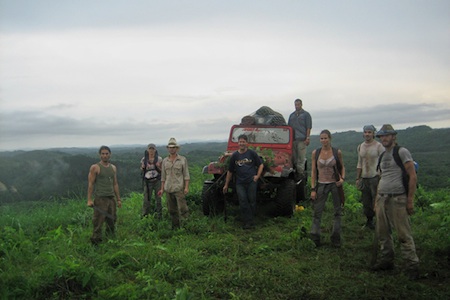Road movies directly challenge [the] culture of conformity. They are about experiencing, above all. They are about the journey. They are about what can be learned from the other, from those who are different. In a world that increasingly challenges these ideas, the importance of road movies as a form of resistance can’t be dismissed.
—Walter Salles, “Notes for a Theory of the Road Movie,” The New York Times Magazine, November 11, 2007.
The road movie, one of the most fundamental and recognizable genres in the history of cinema, is a story type that, appropriately enough, is now well-traveled. Though perhaps as uniquely American in its inception as the Ford Model T, it’s now made its way around the world, with examples from nearly every film-producing nation on the planet.
Director Walter Salles, whose high-profile Kerouac film On the Road is now being viewed at festivals, has clearly been pondering the topic for a good long while. In the 2007 New York Times Magazine article quoted above, he touches on some key points of the genre, whose origin, he quotes Wim Wenders saying, may lie “in our nomadic roots, in mankind’s primal need to leave an account of its passage on earth.”
Of course, here in the States we tend to associate the road movie with one or more piling into a car or hopping on a motorcycle to seek out adventure and some kind of self-actualization. But the definition of the road movie has been expanded, adapted, and upended to include everything from John Ford’s 1939 classic, Stagecoach, to the recent directorial effort by Emilio Estevez, The Way, which takes place almost entirely on a famed walking path, the Camino de Santiago in Spain. The form that the “road” takes isn’t as important as is the people on it, their potential destination, and how they change—or in some cases don’t change—along the way.
As the Wenders quote indicates, this is something almost instinctual for artists the world over. So much so that screenwriters and directors keep returning to the basic road movie building blocks. At least that’s what Thomas Whelan did when he co-wrote and directed the 2007 coming-of-age film The Art of Travel.
The plot is familiar: A young man facing a life crisis finds himself in an unfamiliar part of the globe, embraces it and comes out the other side wiser and happier. No spoilers on that; we all know that’s what’s coming. But Whelan knows as you do: It’s the journey that matters. And so he puts his main character, Connor Layne (played ably by former Malcolm in the Middle co-star Chris Masterson), in the wilds of Central America. There, Layne and a cobbled together gang of fellow misfit wanderers attempt to cross the Darién Gap between Panama and Colombia.
All you need is a Point A and a Point B. It’s what you choose to put into the space between them that counts.
Most directors/writers, though, are more interested in flipping filmic tropes on their respective ears. The road movie is no exception, having been twisted gloriously out of focus by some daring filmmakers.
One of my favorite examples of this is the little-known 2005 French comedy Aaltra. The film follows the model to a tee with a pair of mismatched gents taking to the highways of Europe with a single-minded goal at the end of the road. But everything else about the movie subverts expectation.
The two main characters are utterly irredeemable figures. Played by comedians (and co-directors of the film) Benoît Delépine and Gustave de Kevern, the nameless pair is protagonist and antagonist rolled into one. They’ve both been paralyzed by a freak tractor accident and take off in their wheelchairs for Finland to seek remuneration from the folks who made the product that took away their ability to walk.
In a way, Aaltra is an empowering movie for anyone with disabilities. The two main characters don’t let their wheelchair-bound existence get in the way of seeking justice and adventure. That is until you watch as the two browbeat everyone in their paths, demanding help, food, and a plug-in to power up a motorized scooter. No one comes out smelling clean at the end of this film, and chances are, de Kevern and Delépine’s characters will be just as irascible and pushy if we were to check back in on them a decade later. They’ll probably just have a new target of their collective ire.
On the argument that the prototypical road movie really was born here in America: It was on our long string of highways and interstates that inspired the classics of the genre like Easy Rider, Two-Lane Blacktop, and Sweet Sweetback’s Baadasssss Song. So, when anyone makes a road picture here in the States, they have a lot of history to either embrace or completely shrug off.
In the case of Alex Cox, the English director best known for his striking punk biopic Sid & Nancy, there is an element of both involved in his inclusion in the road movie pantheon, 2007’s Searchers 2.0. In it, the main characters, Mel and Fred, are seeking to exact revenge on a famous director who tortured the two when they were child actors. To do it, they take off from L.A. to Monument Valley, Arizona, where the director will be screening one of his movies.
The action that happens along the way is almost too weird and (I think) wonderful to spoil here. But the thrills are equally rich within the automobile as it travels. They have long philosophical discussions and argue about movies. It’s like a Hope/Crosby flick as scripted by Whit Stillman.
Which offers hope, in a sense, for the road movie, in that it’s truly a difficult genre to pin down—there are so many possible angles and approaches. It’s why directors from two entirely different schools of filmmaking thought, like Dax Shepherd and Wes Anderson, can take it on with equal amounts of authority. All you need is a Point A and a Point B. It’s what you choose to put into the space between them that counts.






